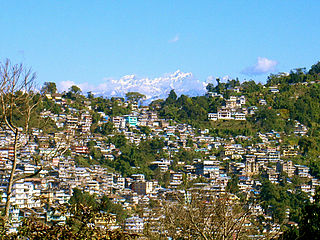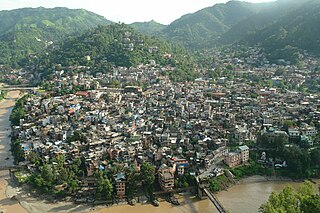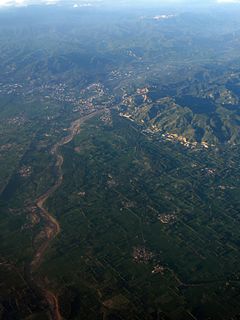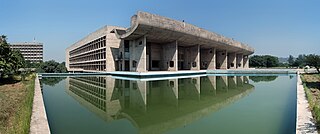
Sirmaur is the southern most district in the south-eastern region of Himachal Pradesh, India. It is largely mountainous and rural, with 90% of its population living in villages. Some of its popular towns include Nahan, Paonta Sahib and Suketi, the latter famous for the Shivalik Fossil Park where fossils over 85 million years old have been found.

The Sivalik Hills, also known as Churia Hills, are a mountain range of the outer Himalayas that stretches from the Indus River about 2,400 km (1,500 mi) eastwards close to the Brahmaputra River. It is 10–50 km (6.2–31.1 mi) wide with an average altitude of 1,500–2,000 m (4,900–6,600 ft). Between the Teesta and Raidāk Rivers in Assam is a gap of about 90 km (56 mi). In some Sanskrit texts, the region is called Manak Parbat. Sivalik literally means 'tresses of Shiva’.

Nahan is a town in Himachal Pradesh in India and is the headquarters of the Sirmaur District. It is also the location of the Indian Army Special Forces Training School. It was the capital of the former Sirmur princely state.

Kalesar National Park and adjacent Kalesar Wildlife Sanctuary are protected areas in Yamunanagar district of Haryana state in India, 122 kilometres (76 mi) from Chandigarh. Both are also contiguous to Simbalbara National Park in Himachal Pradesh and Rajaji National Park in Uttrakhand. Kalesar is a popular destination for leopards, panthers, elephants, red jungle fowl and bird-watching. This forested area in the Shivalik foothills is covered primarily with sal with smattering of Semul, Amaltas and Bahera trees as well. Wildlife jeep safaris are available on 3 tracks. Park is closed July to September and during the remaining months visiting hours are 6 am to 10 am and 4 pm to 7 pm during summers, and 7 am to 11 am and 3.30 pm to 6 pm during winters.

Palampur is a hill station and a municipal council in the Kangra Valley in the Indian state of Himachal Pradesh. It is the tea capital of northwest India, surrounded by pine forests and flanked by the Dhauladhar ranges. The town derives its name from the local word palum, meaning lots of water. There are numerous streams flowing from the mountains to the plains from Palampur. The combination of greenery and water gives Palampur a distinctive look.

Chintpurni is a major pilgrimage Centre and one of the Shakti Peethas in India. The Chintpurni shakti peeth is located in Una district Himachal Pradesh state, surrounded by the western Himalaya in the north and east in the smaller Shiwalik range bordering the state of Punjab. The Chintpurni Shakti Peeth houses the temple of Chinnamastika Devi or Chinnamasta Devi. Chhinnamasta or Chinnamastika temple is one of the 7 major and 51 total Shakti Peethas. Here, Chhinnamasta is interpreted as the severed-headed one as well as the foreheaded-one. The Hindu genealogy registers at Chintpurni, Himachal Pradesh are kept here.
The Geological Survey of India (GSI) currently maintains two protected areas bearing rich fossil deposits.
The development of tribal areas in Himachal Pradesh is one of the major steps taken by the state government for its economic development. The border districts of Kinnaur, Lahaul, Spiti and the Pangi and Bharmour tehsils of Chamba districts are the major tribal areas of the state. They are located near the borders of Tibet and Indian States of Jammu and Kashmir. Other backward areas include Shillai in Sirmaur district, and deep cut-off valleys in the Kullu and upper stretches of Kangra districts. Due to poor accessibility, life in these areas had grown in isolation.

Trilokpur is a temple site in Himachal Pradesh, India, located on an isolated hillock about 24 km south-west of Nahan, 77-15’ north and 30’30’ east, at an elevation of about 430 m.

Sidhbari is a suburb of Dharamshala town, situated in the foothills of Dhauladhar mountains, in Kangra district of the state of Himachal Pradesh, India. The Samadhi of Sri Chinmayananda is located here.
Puadhi is a dialect of Punjabi primarily spoken in the Puadh region of northern India. It is spoken between the Sutlej and Ghaggar river basins in the present day states of Punjab and Haryana, and the union territory of Chandigarh.
Amb is a town situated in the district of Una in Himachal Pradesh state of India. It is situated in the Punjab region of Indian Subcontinent. It is a sub-division and tehsil of Una district. The town was named Amb after the name of the goddess Amba, deity situated in nearby Chintpurni.

Mandi, Mandi, formerly known as Mandav Nagar, also known as Sahor, is a major town and a municipal council in Mandi District in the Indian state of Himachal Pradesh.

Gopalpur Zoo is situated in Gopalpur village, Kangra district, Himachal Pradesh in India, en route the Dharmshala – Palampur road. It is surrounded by Dhauladhar Range of the Himalayas. The zoo is adorned with maple trees, horse chestnut trees, chil and greenery ..Zoo remains closed on every Monday. Timing:- Tuesday to Sunday 09:00AM - 05:00PM.

Bharwain (Hindi: भरवाईं is an hill station situated in Amb Tehsil and hill hamlet village in Chintpurni region in the Una district of the state of Himachal Pradesh in India. It is an entry point to the Chintpurni Temple. The area is situated between the western Himalaya in the north and the Shiwalik range bordering the state of Punjab.

Tangri river, also called Dangri river, originating in Siwalik Hills, is a tributary of Ghaggar river in of Haryana state of India.
Bhanjal is an advance village in Una District of Himachal Pradesh, India.














